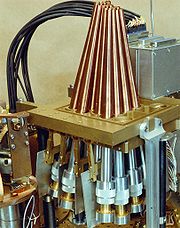
Millimeter Anisotropy eXperiment IMaging Array
Encyclopedia

National Science Foundation
The National Science Foundation is a United States government agency that supports fundamental research and education in all the non-medical fields of science and engineering. Its medical counterpart is the National Institutes of Health...
, NASA
NASA
The National Aeronautics and Space Administration is the agency of the United States government that is responsible for the nation's civilian space program and for aeronautics and aerospace research...
and Department of Energy
United States Department of Energy
The United States Department of Energy is a Cabinet-level department of the United States government concerned with the United States' policies regarding energy and safety in handling nuclear material...
, and operated by an international collaboration headed by the University of California
University of California
The University of California is a public university system in the U.S. state of California. Under the California Master Plan for Higher Education, the University of California is a part of the state's three-tier public higher education system, which also includes the California State University...
, to measure the fluctuations of the cosmic microwave background. It consisted of two flights, one in August 1998 and one in June 1999. For each flight the balloon was started at the Columbia Scientific Balloon Facility
Columbia Scientific Balloon Facility
The Columbia Scientific Balloon Facility is a NASA facility responsible for providing launch, tracking and control, airspace coordination, telemetry and command systems, and recovery services for unmanned, high altitude balloons...
in Palestine, Texas and flew to an altitude of 40,000 metres for over 8 hours. For the first flight it took data from about 0.3 percent of the sky of the northern region near the Draco constellation
Draco (constellation)
Draco is a constellation in the far northern sky. Its name is Latin for dragon. Draco is circumpolar for many observers in the northern hemisphere...
. For the second flight, known as MAXIMA-II, twice the area was observed, this time in the direction of Ursa Major
Ursa Major
Ursa Major , also known as the Great Bear, is a constellation visible throughout the year in most of the northern hemisphere. It can best be seen in April...
.
Initially planned together with the BOOMERanG experiment
BOOMERanG experiment
The BOOMERanG experiment measured the cosmic microwave background radiation of a part of the sky during three sub-orbital balloon flights. It was the first experiment to make large, high fidelity images of the CMB temperature anisotropies...
, it split off during the planning phase to take a less risky approach by reducing flying time as well as launching and landing on U.S. territory.
Instrumentation

Feed horn
In satellite dish and antenna design, a feedhorn is a small horn antenna used to convey radio waves between the transmitter and/or receiver and the reflector, particularly in parabolic antennas...
s. The feed horns have spectral bands centred at 150, 240 and 420 GHz with a resolution of 10 arcminutes. A bolometer
Bolometer
A bolometer is a device for measuring the power of incident electromagnetic radiation via the heating of a material with a temperature-dependent electrical resistance. It was invented in 1878 by the American astronomer Samuel Pierpont Langley...
array consisting of 16 NTD-Ge Thermistors measured the incident radiation.
The detector array was cooled down to 100 mK via a four stage refrigeration process. Liquid nitrogen cooled the outer layer of radiation shielding and He-4 was used to cool the two other layers down to a temperature of 2-3 K. Finally liquid He-3 cooled the array down to operation temperature.
The shielding, together with the properties of the feed horns, gave a superb sensitivity of 40 μV/sec^1/2.
Two CCD cameras where used to provide accurate measurements of the telescope's orientation. The first wide-field camera pointed towards Polaris
Polaris
Polaris |Alpha]] Ursae Minoris, commonly North Star or Pole Star, also Lodestar) is the brightest star in the constellation Ursa Minor. It is very close to the north celestial pole, making it the current northern pole star....
and gave a coarse orientation up to 15 arcminutes. The other camera was mounted in the primary focus and gives an accuracy of 0.5' for stars brighter than 6th magnitude, which in total gives an accurate position tracking of 10' for the telescope and hence of the microwaves.
For pointing the telescope, four motors were used.
Results

BOOMERanG experiment
The BOOMERanG experiment measured the cosmic microwave background radiation of a part of the sky during three sub-orbital balloon flights. It was the first experiment to make large, high fidelity images of the CMB temperature anisotropies...
, MAXIMA's data covers a smaller part of the sky but with much more detail. By the end of the year 2000 the experiment provided the most accurate measurements of the cosmic background radiation (CMB) fluctuations on small angular scales. With this data it is possible to calculate the first three acoustic peaks from the CMB power spectrum. These greatly confirm the standard cosmological model by measuring a baryon density of about 4%, which agrees with the density calculated from Big Bang nucleosynthesis
Big Bang nucleosynthesis
In physical cosmology, Big Bang nucleosynthesis refers to the production of nuclei other than those of H-1 during the early phases of the universe...
. The measurement of the flatness of the Universe
Shape of the Universe
The shape of the universe is a matter of debate in physical cosmology over the local and global geometry of the universe which considers both curvature and topology, though, strictly speaking, it goes beyond both...
also confirms a major prediction of inflationary cosmology
Cosmic inflation
In physical cosmology, cosmic inflation, cosmological inflation or just inflation is the theorized extremely rapid exponential expansion of the early universe by a factor of at least 1078 in volume, driven by a negative-pressure vacuum energy density. The inflationary epoch comprises the first part...
, although BOOMERang was the first to discover this.

